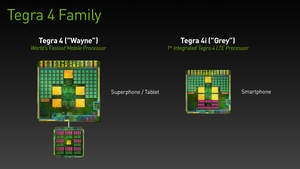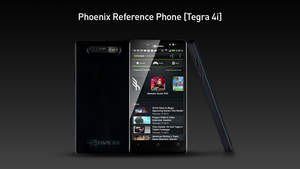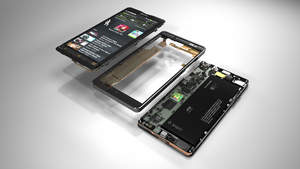SANTA CLARA, CA--(Marketwire - Feb 19, 2013) - NVIDIA today introduced its first fully integrated 4G LTE mobile processor, the NVIDIA® Tegra® 4i, which is significantly faster yet half the size of its nearest competitor.
Previously codenamed "Project Grey," the Tegra 4i processor features 60 custom NVIDIA GPU cores; a quad-core CPU based on ARM's newest and most efficient core -- the Cortex-A9 r4 CPU -- plus a fifth battery saver core; and a version of the NVIDIA i500 LTE modem optimized for integration. The result: an extremely power efficient, compact, high-performance mobile processor that enables smartphone performance and capability previously available only in expensive super phones.
"NVIDIA is delivering for the first time a single, integrated processor that powers all the major functions of a smartphone," said Phil Carmack, senior vice president of the Mobile business at NVIDIA. "Tegra 4i phones will provide amazing computing power, world-class phone capabilities, and exceptionally long battery life."
Tegra 4i's new 2.3 GHz CPU, the Cortex-A9 r4, was jointly designed by NVIDIA and ARM, and is the most efficient, highest performance CPU core on the market in its class.
"Tegra 4i is the very latest SoC solution based on the ARM Cortex-A9 processor and demonstrates the ability of ARM and our partners to continue to push the performance of technology and create exciting user experiences," says Tom Cronk, executive vice president and general manager, processor division, ARM. "ARM and NVIDIA worked closely to further optimize the Cortex-A9 processor to drive performance and efficiency in areas such as streaming and responsiveness. This is an example of the collaboration and innovation that enables ARM technology-based solutions to be market drivers through multiple generations of SoC solutions."
Utilizing the same architecture as Tegra 4's GPU, Tegra 4i features five times the number of GPU cores of Tegra 3 for high-quality, console-quality gaming experiences and full 1080p HD displays. It also integrates an optimized version of the NVIDIA i500 software-defined radio modem which provides LTE capabilities, and makes networking upgradability and scalability fast and easy.
''NVIDIA's Tegra 4i appears to outperform the leading integrated LTE chip significantly, and also benefits from an integrated 'soft-modem' that can be re-programmed over-the-air to support new frequencies and air interfaces -- something other modem vendors can only dream of," said Stuart Robinson, director, Handset Component Technologies Program at Strategy Analytics."
Tegra 4i mobile processor's camera capabilities include the NVIDIA Chimera™ Computational Photography Architecture recently announced in Tegra 4. This delivers many advanced features, including the world's first always-on high dynamic range (HDR) capabilities, first tap to track functionality and first panoramic photos with HDR.
NVIDIA also introduced its reference smartphone platform code-named "Phoenix" for the Tegra 4i processor to demonstrate its unique mobile technologies. Phoenix is a blueprint that phone makers can reference in designing and building future Tegra 4i smartphones to help get them to market quicker.
The Tegra 4i mobile processor will be demonstrated in the NVIDIA booth in Hall 7, Stand #C110, at the 2013 Mobile World Congress show in Barcelona, Spain, on Feb. 25-28.
As a recap, the Tegra 4 family includes:
| Tegra 4 | Tegra 4i | |||
| Quad-Core CPU | Cortex-A15, plus battery saver core | Cortex-A9 r4, plus battery saver core | ||
| Tegra 4 GPU Cores | 72 | 60 | ||
| LTE | Optional via NVIDIA i500 | Integrated NVIDIA i500 core | ||
| Chimera Computational Photography Architecture | Yes | Yes | ||
Useful Links
www.nvidia.com/tegra
www.tegrazone.com
Tags/Keywords
NVIDIA, Tegra, LTE, smartphone, mobile, tablet, quad core, gaming, GPU, CPU, GeForce, Chimera, ARM, HDR, TegraZone
About NVIDIA
NVIDIA (
Certain statements in this press release including, but not limited to, statements as to: the features, benefits and performance of the NVIDIA Tegra 4i processor; the benefits of the Phoenix smartphone platform; and the effects of the company's patents on modern computing are forward-looking statements that are subject to risks and uncertainties that could cause results to be materially different than expectations. Important factors that could cause actual results to differ materially include: global economic conditions; our reliance on third parties to manufacture, assemble, package and test our products; the impact of technological development and competition; development of new products and technologies or enhancements to our existing product and technologies; market acceptance of our products or our partners products; design, manufacturing or software defects; changes in consumer preferences or demands; changes in industry standards and interfaces; unexpected loss of performance of our products or technologies when integrated into systems; as well as other factors detailed from time to time in the reports NVIDIA files with the Securities and Exchange Commission, or SEC, including its Form 10-Q for the fiscal period ended October 28, 2012. Copies of reports filed with the SEC are posted on the company's website and are available from NVIDIA without charge. These forward-looking statements are not guarantees of future performance and speak only as of the date hereof, and, except as required by law, NVIDIA disclaims any obligation to update these forward-looking statements to reflect future events or circumstances.
© 2013 NVIDIA Corporation. All rights reserved. NVIDIA, the NVIDIA logo, Tegra, and GeForce are trademarks and/or registered trademarks of NVIDIA Corporation in the U.S. and other countries. Other company and product names may be trademarks of the respective companies with which they are associated. Features, pricing, availability and specifications are subject to change without notice.
Contact Information:
For further information, contact:
Bruce Chan
NVIDIA
(408) 562-7596
bchan@nvidia.com



